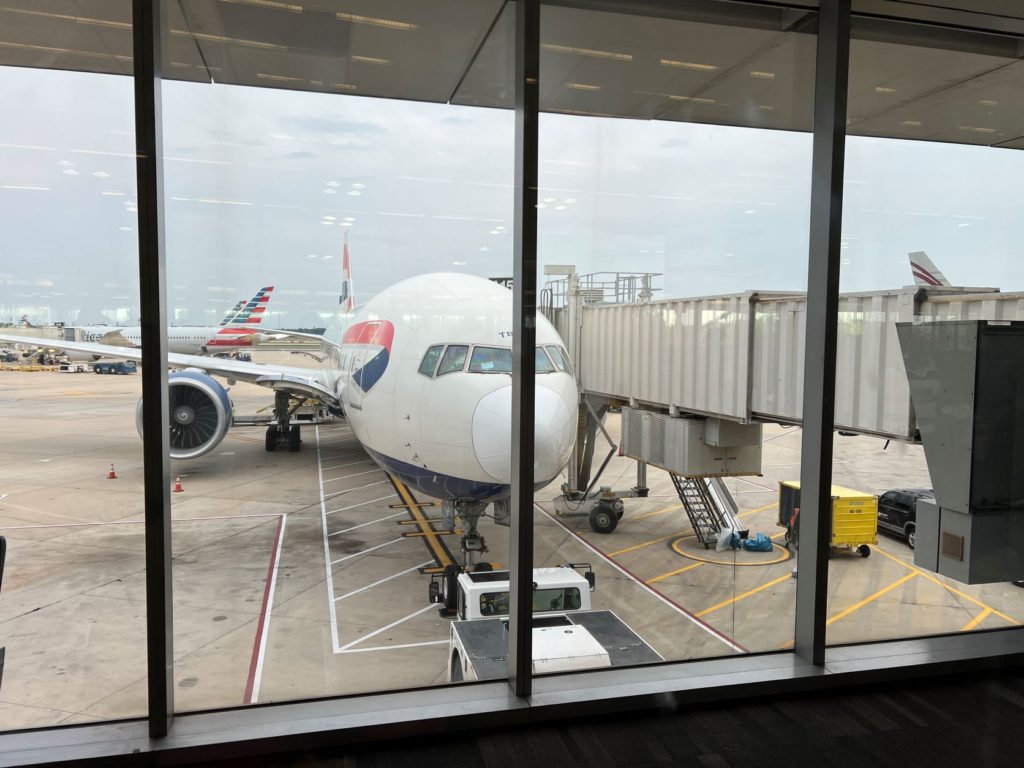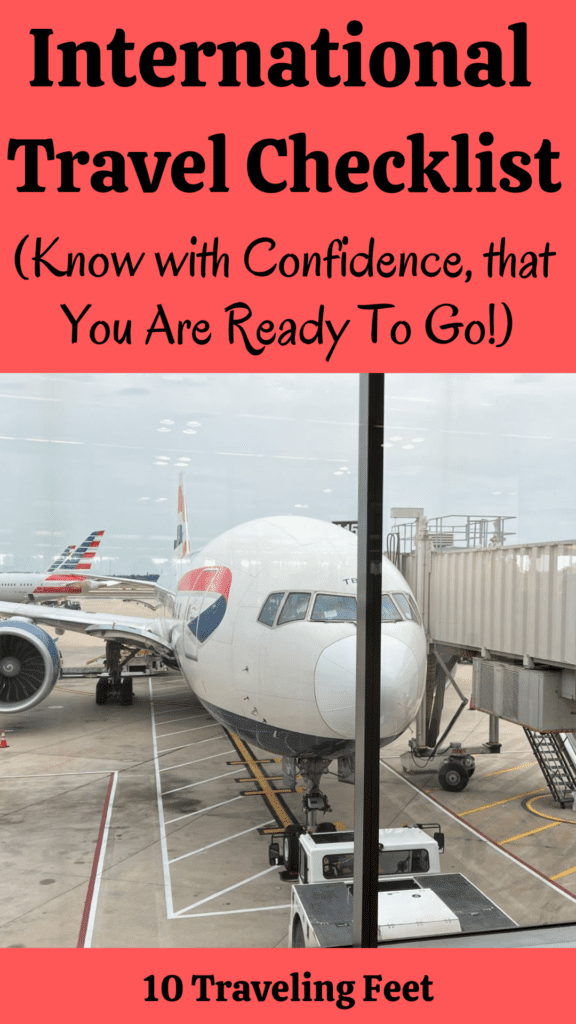
Are you looking for an International Travel Checklist to help simplify what you need to do before you travel?
Whether this is your first time leaving the country or you are a seasoned international traveler, a pre-travel checklist is a must.
Traveling Internationally is so Exciting! But it can also be stressful if you don’t know how to prepare.
With a pre-travel checklist, you can know with confidence that you are all set to go and ready to enjoy your vacation.
Let’s Get Started!
INTERNATIONAL TRAVEL CHECKLIST
1. CHECK YOUR PASSPORT
- First, make sure you have a passport. If not, do this right away. This is one item you definitely can not travel internationally without.
- How to Apply for a Passport
- Note: U.S. Passports routinely take 7 to 10 weeks to process once received. If Expedited, for a fee, it routinely takes 4 to 6 weeks.
- If you have a passport, check that it has not expired.
- Note: Passports must be valid for at least 6 months after your trip.
- Family Tip: Child Passports are only valid for 5 years, not 10 years like adult passports, so double check when they expire.
- Also, check that your passport has enough pages for any Visa Entry/ Exit Stamps.
- Travel Tip: Pack a copy of your passport’s picture page (and an extra passport photo) with you, in a separate place from your passport, while traveling. This will allow for a much quicker replacement if it is needed.
2. IMMUNIZATIONS and HEALTH
- Check if your travel destination requires or recommends any specific immunizations, or malaria pills. Also check if your destination needs any specific documentation for entry.
- This can be easily found on the CDC’s website.
- Destinations such as Europe, usually only recommend the routine vaccinations that you probably already have if living in the United States.
Yellow Fever
- Several countries require specific vaccination documentation, like the Yellow Fever Vaccine “CDC Yellow Book” for entry. Examples are countries like Brazil, Argentina and Peru to name a few.
- But also, check out any requirements for traveling between the countries you are visiting as well. Because although one country may not require a vaccine if coming from the United States, they may require it if coming from another country.
- For example, this happened to us when visiting Kenya. They do not require a Yellow Fever Vaccine, yet they do require one if you are traveling from a country with risk. For us, this was traveling just over the boarder to Tanzania (and Serengeti National Park.) Therefore, we did need to have a CDC Yellow Book with our Yellow Fever Vaccination in it so that we could get back into Kenya to fly home.
- Note: The Yellow Fever Vaccine can be hard to find, due to manufacturing problems, so look into this right away if you need this vaccination. (We were only able to find it at Passport Health, so check there if you are having trouble too.)
Other Vaccines & Malaria Pills
- For most vaccines or malaria pills, you can easily get them from your doctor, your pharmacist or from the County Health Department.
- Also, make sure you check the current Covid entry requirements for your destination. (And then check them again closer to your trip in case they’ve changed.)
- Note: Many countries have begun using a global certificate of vaccination for Covid. So check to see if you need to upload your vaccine information onto a specific site. In many countries this will wave any need for a PCR test for entry. (Always check with your destination for the most current information.)
3. CHECK IF YOU NEED A VISA
- Americans are able to travel to most of Europe, Central & South America and to most of the Caribbean without a visa. (Always double check your destination before you travel.)
- Yet, many destinations do require a Travel Visa, for a fee, before you are allowed to enter their country.
- Here are a Few Popular Destinations for U.S. Citizens that DO REQUIRE A VISA.
- Australia, China, India, Kenya, Tanzania, Madagascar, Egypt, Turkey, Russia, & Vietnam to name a few.
- Many times a visa can be applied for online and many countries require this to be done in advance. Whereas other travel visas need to be acquired at the airport when you arrive.
- If a travel visa needs to be done in advance, allow several weeks for processing.
- To check entry requirements and visas for any country, visit the country’s Embassy site online for up to date information.
- Another great source of information is State Department Website. Here, on the left hand side, search the country that you will be traveling to for all of the important information you’ll need to know.
- Here are a Few Popular Destinations for U.S. Citizens that DO REQUIRE A VISA.
4. CONSIDER TRAVEL INSURANCE
- Travel insurance is recommended in case of an unexpected cancelation or medical need during your trip that your regular insurance doesn’t cover.
- Make sure to take a copy of your policy and any contact information with you on your trip in case you need to use it.
- Also, leave a copy with your emergency contact person as well.
5. CHARGING YOUR DEVICES
- Countries around the world have different plug outlet configurations, so you may need to buy an adapter/converter kit in order to charge your electronics while traveling.
- Popular Adapter Kits for charging devices anywhere in the world. Some even have phone charging ports with them!
- Popular Voltage Converters/ Adapter Kits for items like hair dryers or straighteners when traveling internationally.
6. MONEY
- Know the currency of the country you are visiting and the current exchange rate. Find current exchange rates here.
Credit Cards
- Check to make sure your credit card is widely accepted at your destination country (and bring more than one type.)
- Some card brands are more accepted than others, depending on the country. Look for this information on your credit card’s website, so you’ll know which ones to bring.
- Also check if any of your credit cards do not charge a foreign transaction fee. (This could save you a decent amount of money in fees.)
- Before you leave, let your credit card company know your travel dates and destinations so that your transactions won’t get denied while traveling.
Cash
- Ways to get local currency:
- You can exchange money at the airport when you arrive.
- You can order some of your destination’s currency at your bank at home, several weeks in advance, so that you arrive with a little cash already in hand.
- Or you can just choose to visit an ATM in that country when you need cash as you travel.
- Some countries may accept U.S. currency as well. But know, that some of these countries will only accept crisp, clean, new bills to exchange (and only dated 2010 or later) so check on what type of U.S. currency would be accepted before you go.
7. CELL PHONES
- Check out your cell phone carrier’s International Plan.
- If you don’t want to pay for the international plan:
- You can try using your phone for free when you have access to Wi-Fi (like at the hotel.)
- Make sure your Cell Data & Roaming are turned off!
- This sounds like a great idea. But on our last trip we tried it and while most of the time it worked wonderful (and had no charge), there was one day when the WiFi at the hotel must have dropped us and we ended up with a decent Roaming Charge. (I thought we had roaming turned off, so we’re still trying to figure this one out.) But, even though it was an unpleasant surprise, the bill was still cheaper than if we had used the International Plan for 2 phones for 10 days. So just know that this option may not guarantee you having no charge (at least it didn’t for us.)
- You could also get a local Sim card if you have an unlocked phone. (Although this will not work if your phone is locked.)
- Tip: You can sign up for the International Plan for just one phone and only use that one phone, if you are looking to save some money.
- You can try using your phone for free when you have access to Wi-Fi (like at the hotel.)
Family Tip
- Know that when you enter into another country, your phone will automatically ask you if you want the international plan. You must deny this if you do not want it. And you have to do this for each country you enter. And you must have your children deny it on each of their phones too. If this is not denied, then that phone will be automatically enrolled & charged with the International Plan Rate.
- (We forgot to have one of our children deny the International Rate plan when entering into a different country and they were immediately charged $10 for that day for accessing just one thing on their phone. Now that you know what to look out for, I hope this won’t happen to you too!)
- Know that when you enter into another country, your phone will automatically ask you if you want the international plan. You must deny this if you do not want it. And you have to do this for each country you enter. And you must have your children deny it on each of their phones too. If this is not denied, then that phone will be automatically enrolled & charged with the International Plan Rate.
8. PERSONAL MEDICATIONS & HEALTHCARE NEEDS
- Aside from Immunizations, make sure you have enough of your personal prescription medications, extra contact lens, or other healthcare related items that you use and may need while traveling.
9. COPY ALL IMPORTANT DOCUMENTS
- Make sure you have a copy of any important documents for your trip in at least 2 different places.
- Passport Information Page
- Any Visas
- Covid Vaccination Cards
- Any Covid Global Registration Card
- Your Yellow Fever Vaccination “Yellow Card” if near countries that might ask for it.
- A copy of your Driver’s Licenses
- Your Itinerary
- And your plane flight information/ locator code
- I like to keep one digital copy on my phone and a paper copy in my carry-on. I also email our itinerary and plane info to my husband, so we both have easy access to it.
- It’s also good for your emergency contact, that’s not traveling with you, to have access to any important information as well.
10. VERIFY AIRLINE CARRY-ON & CHECKED LUGGAGE RESTRICTIONS
- Before you start packing, verify any baggage restrictions your airline may have so you don’t get caught off-guard and wind up with a big fee.
11. FIND OUT IF IT IS SAFE TO DRINK THE WATER
- In some countries it is not safe to drink the water and so you should only drink bottled water when visiting.
- In other countries, it isn’t even safe to brush your teeth in the tap water, and therefore you must use bottled water for this as well!
- It’s good to know what is safe to do before you travel so that you can be prepared. Hopefully this can help prevent you from getting stomach problems or worse.
12. PUT A HOLD ON ANY REGULAR DELIVERY SERVICE YOU USE
- Put a hold on your Mail Service, Newspaper Service or any regular delivery service you have so that items don’t pile up at your house, letting everybody know that you are not home.
13. ARRANGE CARE FOR YOUR PETS
- This goes without saying, but sometimes it can be forgotten until right before your trip and then you’re in an all out panic to find acceptable care for your wonderful pets.
14. PREPAY ANY BILLS ONLINE AHEAD OF TIME
- No one wants to think about paying bills while on vacation, so a week or two before you leave, go through all of your regular bills and see if you can set up future online payments for them. This way you can have a more relaxing vacation as well.
15. PREPARE YOUR HOUSE FOR YOU TO BE GONE
- Turn your air up, or heat down (depending where you live and the time of year you are traveling.) Why pay for something if you are not there.
- Turn off the house water (so you don’t have an accidental leak while you are gone.)
- If you will be gone for a while, squirt a little toilet bowl cleaner in the toilet before you leave so that you don’t come back to a rusty ring in your toilet from the water just sitting there too long.
- Give your house key to a neighbor or trustworthy friend so that they can keep an eye on your house while you’re gone.
- We had one trip, where when my parents came to check on our house, they saw that our air conditioning unit in the attic had leaked and caused a huge hole in our ceiling! We were so grateful that they found this before the damage became even worse.
And of course it goes without saying that you will need to plan your itinerary and make/ double check any necessary reservations as well.
Now you are all set for Your International Trip!
I hope everything goes smoothly and that this international travel checklist helped. Please let me know if you have any comments, questions or additions to this list, in the comments section below.
Have a Great Trip with Your Traveling Feet!
If You Found This Post Helpful, Please Share / Pin It

You May Also Like:
10 Traveling Feet is a participant of Amazon Associates which means means we may receive a small commission, at no cost to you, if you make a purchase through a link. Thank you for supporting 10 Traveling Feet.



